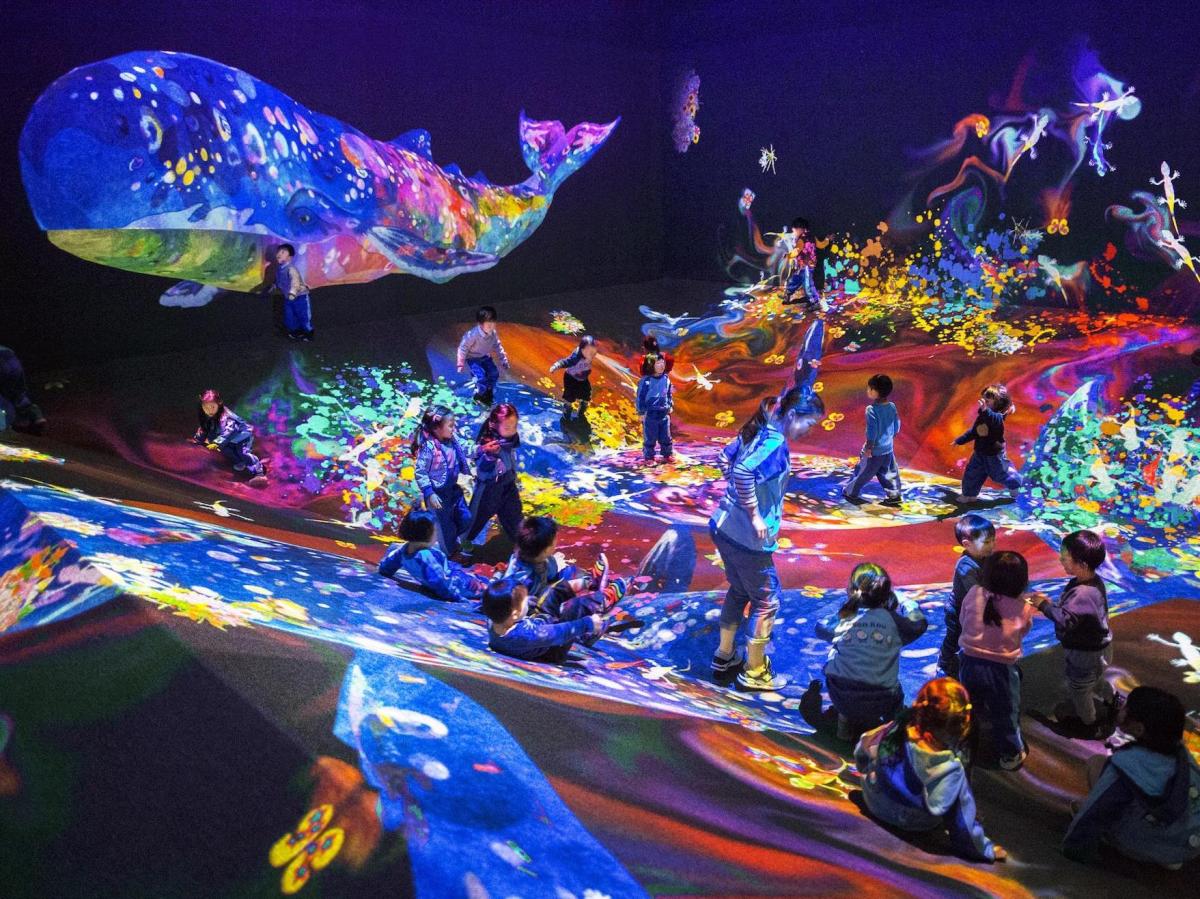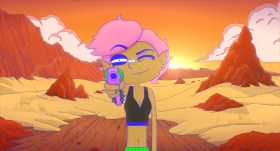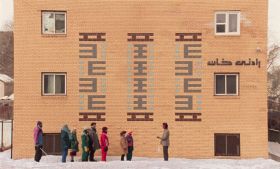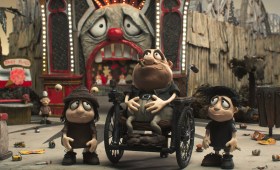Graffiti Nature – Mountains and Valleys installation view, supplied courtesy teamLab
How long has it been since you have played hopscotch or coloured in with crayons? This is exactly what Japan’s teamLab ask you to do – to leave everything at the door and re-engage your imagination and sense of awe.
Renowned for creating immersive digital worlds for kids and adults alike, their latest exhibition, Future Park has opened at Sydney’s Powerhouse Museum, MAAS. It has toured to Japan, America, Thailand, Taiwan, Latin America and Indonesia, and been seen by hundreds of thousands of people.
Its success is not surprising – the exhibition’s eight interactive light-sound installations are captivating as they evolve in real time and in response to human interactions. teamLab’s founder, Toshiyuki Inoko told ArtsHub the public reaction is different every time. In Japan the parents stood formally back, while in Latin America the parents were in there fighting over the crayon colours with the kids.
Unlike some video installations that have a more static engagement, teamLab’s digital playgrounds require exactly that of viewers – that you bring out your own sense of play.
Walking into the space there is an immediate retinal punch of hyper-saturated colour and light. Think a 21st century Willy Wonka-land.
The first installation you encounter is Light Ball Orchestra, a field of around 80 light-filled, sensor driven acrylic balls in varying size that you move through, roll over, push around and look up into as they hover over you… each responding to your touch by changing colour. It’s like Gymboree play balls for adults.
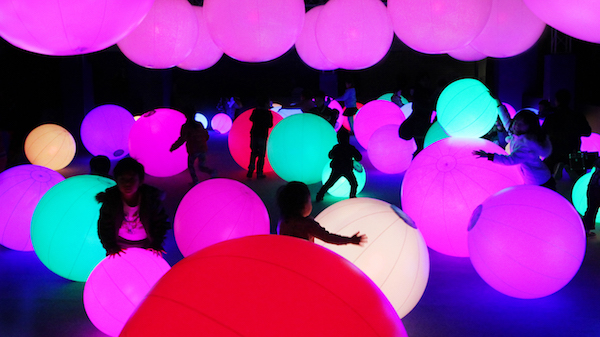
Installation view, Light Ball Orchestra; image supplied courtesy teamLab
In a side gallery is Sketch Town, where visitors are invited to sit down and colour in a UFO, rocket, buses, rescue vehicles, buildings – 12 templates in all that you then scan on a flatbed, and it instantly zooms into the digital landscape, joining the animation.
Unlike reality, it is a town of collective imagination. You control the movement in the town and when a cartoon monster appears the town’s future is in your hands.
But there’s more. Sketch Town Papercraft takes visitor drawings and scans them into 3D sketches that can be printed as 3D models.
Working along similar tech processes is Sketch People, where you can select a drawn figure, colour and scan – and then bang, there they are: walking around, interacting with others and forming new relationship in this digital world.
Hopscotch for Geniuses takes the age-old game and gives it a digital twist. As you move through the squares, they explode in your wake in a bust of colour and light. Similarly, in the installation Graffiti Nature – Mountains and Valleys (pictured top) your movement up an artificial slope into a valley of cushions is paved again by blots and explosions of colour and painterly gestures.
Mere descriptions of these installations undersells their experience. Even just moving around through the space, the artworks seemingly transform before you, triggered by your movement and behaviour. There is not a better phrase for it (albeit one that is a bit clichéd) as awe-inspiring.
And the nice thing – it democratises the art experience. Plus, I love that the Powerhouse Museum have created Adults Only Nights for this exhibition, on Thursdays through January, 5.30 – 9pm.
MAAS Director and CEO Dolla Merrillees said: ‘Last summer we welcomed six Egyptian mummies from the British Museum in an exhibition that was enjoyed by over 100,000 visitors. This summer we are excited to invite visitors to build a collective artwork, imagining future worlds the ancient Egyptians could only have dreamed of.’

Installation view, Sketch Town as exhibited in Japan; image supplied courtesy teamLab
Marriage of Analog and Digital
It is almost impossible to recall the pre-digital world that existed just a few decades ago as one moves though this exhibition. But it is our very digital world that inspired teamLab’s founder, Toshiyuki Inoko. He told ArtsHub that it was from observing his child with their head constantly inclined down towards a smart phone that compelled him to change their behaviour and broaden that world.
The greatest delight within this exhibition is that blend of analog and digital. You sit down and colour in, and in turn bring your own imagination and creativity to this fantastic new world engagement.
It reinstates analog action as fun, and reminds kids that making is just as important as swiping.
Another team member, Shizuka Sasaki, who was in Sydney for the installation, said that the way people draw is very different from one country to another.
‘In the US the colour combination is very different from Japan – they go outside the lines, people think very freely, that’s very different from Japanese people who are very neat, the combinations are [predictable]. And in Taipei it was lots of couples, adults, maybe because in Taiwan selfies are popular.’
The exhibition is very social media friendly, which again can be thought of as connecting to a collaborative philosophy of reaching out and sharing, as well as the individual using their own creativity bolstered by technology.
A 450-strong collective
TeamLab‘s philosophy is all about collaboration, putting your ideas out there so others can see and adjust them. As their name suggests, it’s a team effort.
Inoko told ArtsHub that there are no notebooks in their meetings at the organisation’s Tokyo headquarters. He explained that conversations and ideas are formed by drawing directly on the table, with other member sitting around and adding to the mind map.
He added, ‘There is no hierarchy.’
The company was formed in 2001 with some college friends, basically doing database work to pay bills. But in 2011 they had their first exhibition, and in 2013 showed their first ‘digital playground’ in Okinawa, Japan. Today they have exhibited on almost every continent.
teamLab is not just a creative aberration of “tech geeks” – the 450-strong collective today includes artists, designers, architects, coders, computer engineers, animators, mathematicians and editors. They like to describe themselves as “ultratechnologists” and see themselves occupying a hybrid space between art, science and technology.
While we hear a lot about this space, and it has generated a kind of buzzword energy, this exhibition is an example where that axis is truly played out without ostracising anyone for their tech failings. Rather it is an incredibly successful bridge that brings old and new creativity together.
I have to agree with Merrillees, who said: ‘It is so special to witness creativity at its source.’
Rating 5 out of 5
Learn & Play! teamLab Future Park
24 November 2017 – 30 April 2018
Powerhouse Museum, 500 Harris Street, Ultimo NSW 2007
Tickets available from Ticketek
www.maas.museum/event/future-park/
Actors:
Director:
Format:
Country:
Release:
